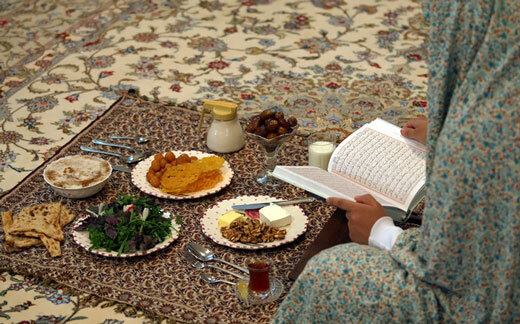What’s it like visiting Iran during Ramadan?

They say for all human beings there is a time to sow and a time to grow under the never-ending generosity of the Almighty God.
For a faithful Muslim, the ninth month of the lunar Islamic calendar, Ramadan, also known as “Ramazan-e Karim” (benevolent/merciful Ramadan), is a time for, more than ever, practicing humility, patience, simplicity, empathy, and acceptance when things don’t go their way. It’s also a time to make stronger bonds of fellowship.
Muslims observe religious fast from dawn (fajr) to sunset (maghrib) and pray more than usual and with even more intensity to get closer to God. Ramadan is traditionally a time of great hospitality and generosity, so go ahead and accept Ramadan sweets or invitations to feasts, parties, and family gatherings. For Muslims, everything is done ceremoniously and consciously in line with what has passed down from generation to generation.
Muslims’ goal to observe Ramadan rituals is to resist temptation in all forms. The purity of thoughts, intentions, and deeds are underlined while the road to self -discipline, self-control, sacrifice, and compassion and affection is paved by will power and endurance.
If you’re planning on traveling to Iran or other Muslim-majority countries during this time, you’re blessed to gain an utterly fascinating experience. During such a time, however, there are some dos and don’ts you should be mindful of.
As a foreign traveler, you should be respectful of the culture and beliefs of the country you are the guest of. Avoid eating in front of Muslims during the month, just eat somewhere quiet, or at least in obvious tourist areas.
Eating, drinking, and smoking in the public are strictly prohibited as they are considered acts of temptation; especially for locals, where failing to observe Ramadan may attract penalties. However, there are exceptions for the ill, pregnant, or physically weak people and even long-distance travelers!
In reverse, during Ramadan, one can eat their heart out from sunset to sunrise. Pretty much every restaurant, food stand, and even households have food ready after dark.
After a long day’s observance of fasting from dawn, Muslim families gather at sunset to break their fast over a meal known as Iftar, which is typically more than just food at the end of a ritualistic day.
During daytime all restaurants and coffee shops are closed, however, by the sunset, street Iftar meals are ready to grab for those who cannot reach home in time for breaking their fast.
To bring more comfort to the faithful, work schedules in Iran are modified during this month to make the experience of this month as convenient as possible.
This year’s Ramadan began on April 25, which falls in the spring season in Iran and it is estimated to end on May 24.
Because of the nature of the lunar calendar system, the dates of Ramadan vary each year and there is always a sort of disagreement among scholars as to when does Ramadan precisely start or come to an end.
By tradition, the new moon crescent which is sighted by the naked eye marks the beginning of a new lunar month but these days Muslims prefer to lean towards astronomical calculations to avoid such confusion.
Ramadan comes to an end by Eid al-Fitr, a joyful holiday when Muslims celebrate 29 or 30 days of dawn-to-sunset fasting; complemented by lots of traditional food and family get-togethers.
AFM/MG
